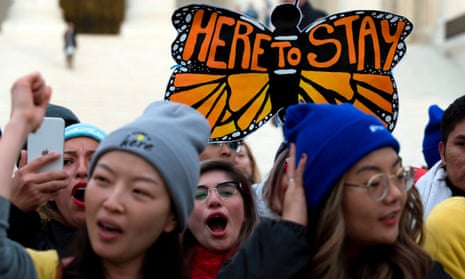On Tuesday the US supreme court will hear arguments that will determine the future of the Deferred Action for Childhood Arrivals (Daca) program. Established by the Obama administration in 2012, Daca has provided renewable two-year work permits and temporary relief from deportation for young immigrants who moved to the United States as children. To date, Daca has provided more than 800,000 young people opportunities to pursue their dreams and reach their full potential. Daca is perhaps the most successful policy of immigrant integration in the last three decades.
If the supreme court rules that Trump illegally ended Daca, these young beneficiaries will continue to thrive and build on their successes. If the supreme court rules in favor of Trump, however, its beneficiaries will be stripped of their newfound rights, and much of their progress will be reversed.
This week, we released a report which demonstrates how much is at stake in this supreme court decision. Our report outlines findings from the National UnDACAmented Research Project, a longitudinal national study we launched to understand the impacts of Daca on beneficiaries. In 2013 we carried out a national survey of 2,684 Daca-eligible young adults. In 2015, we conducted face-to-face interviews with 408 Daca beneficiaries. We followed up with these respondents in 2016 and 2019.
Our findings demonstrate the broad and profound impact Daca has made on beneficiaries, their families and their communities these past seven years. When we first met, our respondents were harnessing newfound opportunities to work, drive, establish credit, access health insurance and enroll in postsecondary programs. For those who had previously left high school, Daca motivated them to enroll in GED and adult education programs. For those seeking higher education, Daca improved access to vocational programs, community colleges, universities and graduate schools.
Work authorization has enabled our respondents to obtain new jobs, access higher wages and pursue meaningful and stable careers. Growing financial stability and a sense of security improved respondents’ health and wellbeing and produced profound domino effects for families and communities.
When we first met a young man called Gabriel, he was studying biology at a public university in New York. Daca enabled him to secure paid positions in the science and health fields to build experience for medical school. He graduated from college, took the MCAT, and is now in his third year of medical school. He is studying to become a doctor of internal medicine and hopes to one day provide healthcare to underresourced communities.
Gabriel’s future depends on Daca. An end to this program would rob him and thousands of other young people of years of hard work, investments and progress. Terminating Daca would be catastrophic not only for these individuals but for their families, communities, and our country. It makes little sense to end a program that now benefits so many people.
Roberto G Gonzales, PhD, is professor of education at Harvard University and author of Lives in Limbo: Undocumented and Coming of Age in America
Kristina Brant is a PhD candidate in sociology at Harvard University and a doctoral fellow in the multidisciplinary program in inequality and social policy at the Harvard Kennedy School
